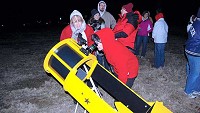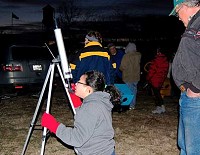Midwestern Astronomers share their knowledge of night sky
It was a fascinating night of extraterrestrial exploration Friday, Feb. 11 in Chilo Lock 34 Park.

Rismiller said the Fort Wright, Ky. group partners with the Cincinnati Observatory to put on six public stargazing programs each year.
“It’s something we like to do, and obviously people are interested,” Rismiller said.
Clermont Park District Chief Naturalist Keith Robinson said he was very impressed with the turnout.
“We were hoping for about 30 people and it looks like we doubled that,” Robinson said.
“It’s a great opportunity for people of all ages to find out about planets and stars above us,” he said in a press release for the event.
Pete and Alma Lung, of Felicity, brought their children down for the event.
“My mom bought my son a telescope and when I read about this in the paper we just had to come down,” Lung said.
She said her children enjoy using the telescope and it helps her reinforce what they are learning in school.
Teacher Lauren Hickey, of Milford, also wanted to reinforce classroom lessons and give her children an opportunity to get a closer look at the distant lights in the night sky.
“I teach at West Clermont and I invited my class to come down,” Hickey said.

He focused one telescope on Jupiter as it sped through the southwest corner of the night sky. The telescope showed Jupiter’s storm clouds and three of its moons. He pointed his 10 inch telescope at the moon to get a look at its craters at 78 times the magnification of the naked eye.
Rismiller said that while the summer sky is full of more objects as the Earth points towards the center of the Milky Way, the winter sky is more accessible to younger astronomers who may be in bed before the sun sets during the longer days of summer.
As a large cloud bank rolled in, the crowd moved inside a nearby yurt hut to get warm with a cup of hot chocolate and Rismiller gave a presentation on Jupiter and astronomy in general.
